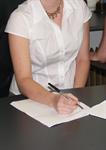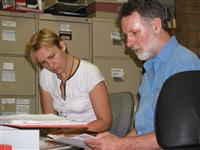
Take your editing skills to the next level with this intermediate course.
Hone your editorial skills with this intermediate level course. Building on the material from Editing I, Editing II expands your knowledge of text types and the different types of language used within each. This course is an important step in opening your editing horizons, proving the knowledge and practice you need to work with books, features, technical documents, and more. At the end of the course, you'll test your skills with a practical editing project.
Student Testimonial:"I found the course to be extremely helpful. It has given me the confidence and skills to present my work to publishers."~ Dilys
Course Duration: 100 hours
COURSE STRUCTURE
There are 8 lessons in this module as follows:
- Introduction to Editing
- Scope and nature of editing
- Traditional and modern editing
- Terminology
- Writing job specifications
- Refining Text Editing
- Common traps
- Proofing documents
- How much editing, manuscript assessment
- Editorial roles
- Terminology
- Editing Headings
- Headlines
- Captions
- Supporting material
- Terminology
- Graphics
- Line drawings, technical illustrations
- Processing graphics
- Selection and design with photos
- The editor's role
- Terminology
- Editing and Design
- Layout and design
- Desktop publishing software
- Image manipulation
- Matching Style and Context
- Targeting the reader
- Style
- Terminology
- Legal and Ethical Issues
- Legal and ethical issues in publishing
- Copyright
- Law and the internet
- Libel and defamation
- Terminology
- Editing Project
- A practical editing project to end the course and utilise your new skills.
COURSE AIMS
- To review the current state of editing, determining its scope, nature and trends.
- To identify and edit text errors that commonly occur in a variety of publishing situations.
- To write and edit a variety of different headings and captions.
- To select, edit and mark up graphic illustrations.
- To edit the layout or design of a publication.
- To identify an appropriate style for the context of a publication, and edit the text to match the determined style.
- To edit text in order to remove legal and/or ethical risks.
- Apply a broad range of skills to editing of a lengthy manuscript in a balanced way.
Do You Know the Language Editors Use?

Agony Column
A regular feature containing items related to personal problems; such as readers’ letters and editorial advice.
Alignment
The ranging of type along its base line and the horizontal and vertical ranging of columns.
Angle
The specific perspective from which an item is written.
Arm
The horizontal stroke or line of a capital letter (eg. P or F).
Artwork
Any type of illustration including a photograph, drawing, or computer generated graphic.
Ascender
The stroke of a lower case letter that extends higher than the height of an “x” (eg. the top half of the letter “b”).
Author’s corrections
Alterations made to text by the author, after the main editing has been finished, but before final printing.
Back bench
Senior editorial executives of a publication (usually refers to senior staff in a large newspaper).
Back margin (or Back)
The inside margin of a page (ie. where the two pages join together).
Banner
A major headline that extends across the top of a page.
Barcode
An optical representation of an ISBN number which identifies a publication. The code is read by a computer.
Blanket
A rubbery sheet that is clamped around a cylinder, that contains an image used in offset printing to transfer that image to paper as it moves through the machine.
Bleed
An illustration is placed on the edge of a printed area, so that when the paper is trimmed, the illustration extends to the edge without any margin.
Block
This is commonly an engraved image on a flat metal plate, which is used to transfer an image when printing using a “letterpress” technique.
Blow up
An enlargement of a photograph or other type of illustration.
Blueprint
Same as dyeline.
Blurb
A description of a book, and perhaps an author profile, printed on the cover or inside sleeve and any publicity material for a book.
Book block
The bound pages of a book, before attaching to the cover.
Box
A section of text or an illustration (or both) ruled off on four sides to create a square or rectangular section within text. Tables, line drawings and “emphasised” statements, such as quotations, are often set in boxes.
Break Out
A second (or further) item on the same page as the main story (eg. you may have several items that are unrelated on the same page, though the page is dominated by one main item).
Breaker
Anything used to break up text in a page, such as a quote or crosshead.
Brevier
An old name used to refer to 8 point type.
Bromide
A print of a photograph, illustration or typeset material made on standard light-sensitive photographic paper; from which an image is taken for printing.
Bullet point
A black mark (eg. A dot, triangle, dash) in front of text to create an effect or highlight – often used on tabulated lists, sometimes on headings.
Working as an Editor or Proof Reader
Anything that is written can probably be improved by editing. This includes:
- Articles
- Books
- Newsletters
- Web Sites
- Blogs
- Marketing Materials
- Legal Contracts
- Reports (government, business, research, etc)
Editors are employed both because they can bring a fresh pair of eyes to a piece of writing; and because they can save the writer time and money. When anyone writes anything; they tend to get so close to their work that after a while, they don’t readily notice mistakes. An editor is always going to see the material with a fresh pair of eyes, and usually notices things that the writer may be repeatedly overlooking.
Some work may require an editor who is also knowledgeable about the material (eg. Someone who understands both chemistry and editing is needed to edit chemistry).
Editors may perform some, or all of the following tasks:
- Improving it’s relevance to the intended audience.
- Providing an impartial view before the writing is released to it’s intended reader(s).
- If necessary, restructuring content to present it more logically.
- Altering the tone or style of language to be more appropriate to the purpose.
- Identifying errors or inadequacies in grammar, spelling, clarity and conciseness.
- Identifying inadequacies in layout or illustration.
- Improving consistency.
WHAT NEXT?
Improve your existing editing skills. Develop marketable and efficient editing skills. Editing is a highly sought after skill. You may use it in your workplace or personally.
Editing is an important skills. If you have a website or blog or write catalogues or information generally, producing high quality, written material is important. How many documents and websites are let down by bad spelling and grammar?
If you want to be an editor - freelance or employer - or would like to improve your own writing and the writing of colleagues, this course is the one for you.
Register to Study - Go to “It’s Easy to Enrol” box at the top of the page and you can enrol now.
or
Get Advice – Email us at info@acsedu.co.uk OR
Use our FREE COUNSELLING SERVICE to contact a tutor
CLICK TO CONTACT US